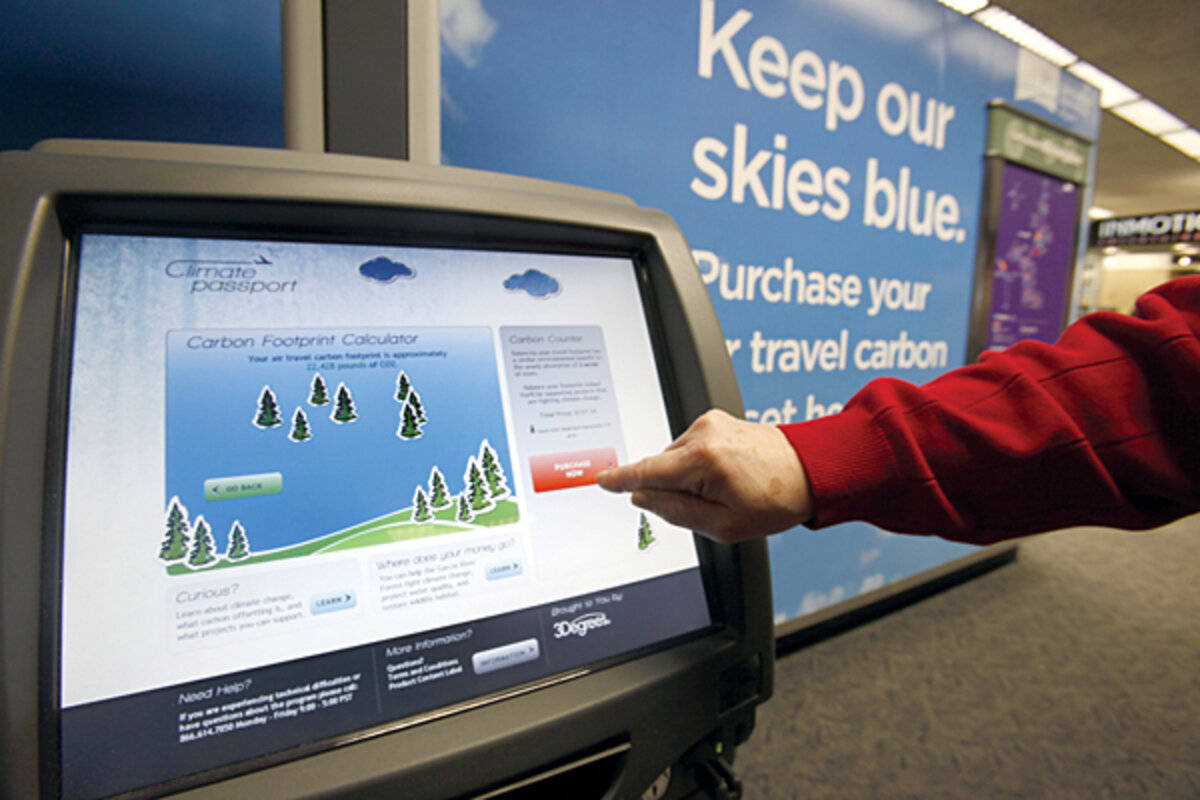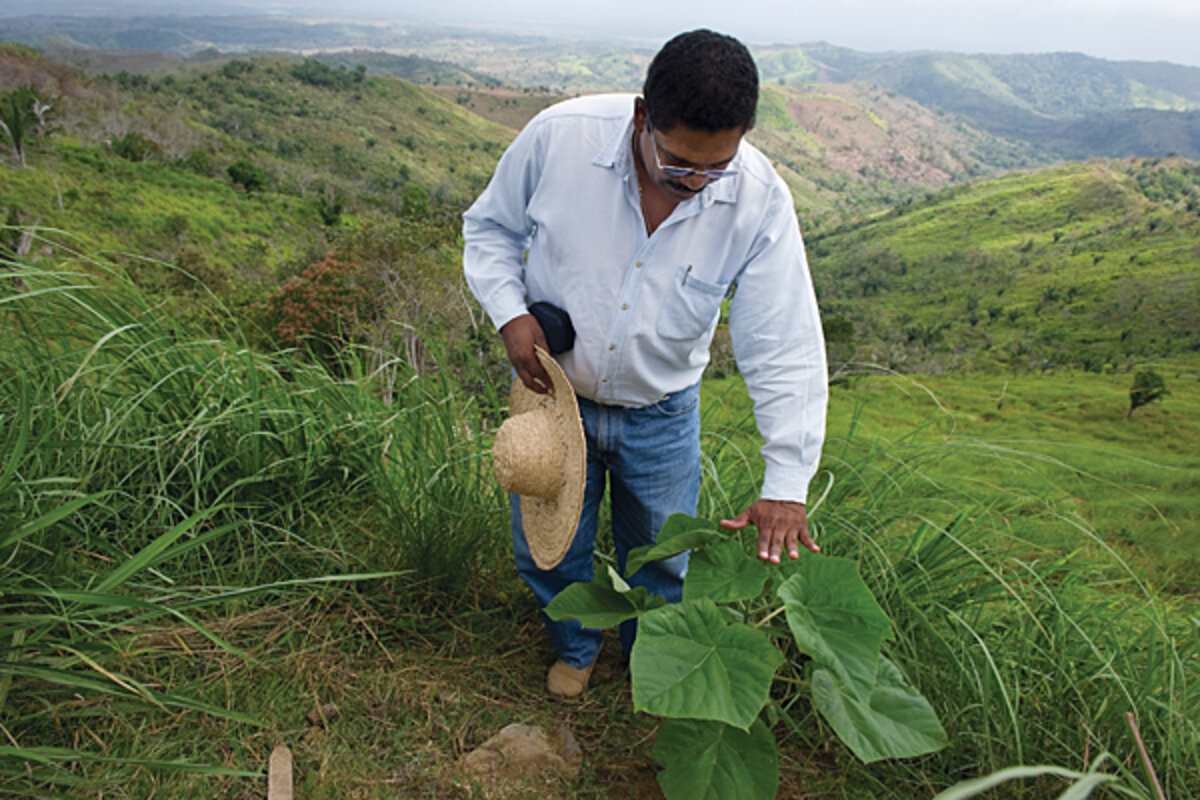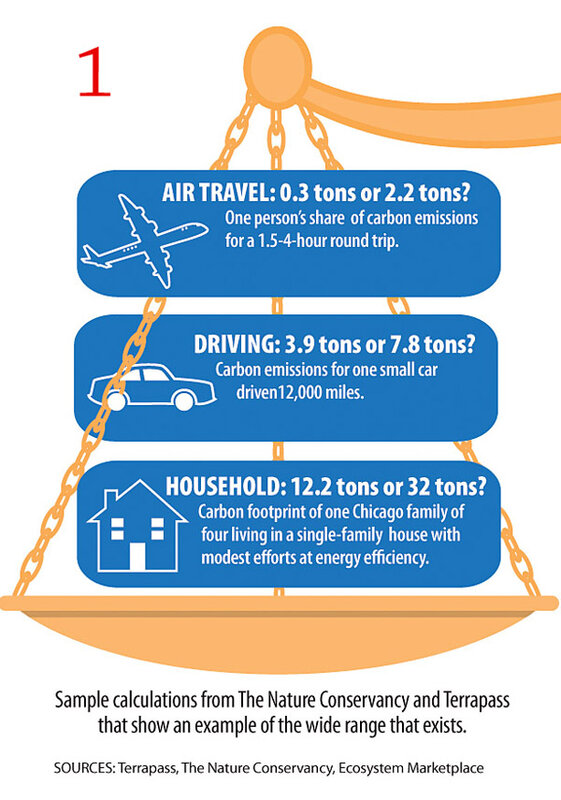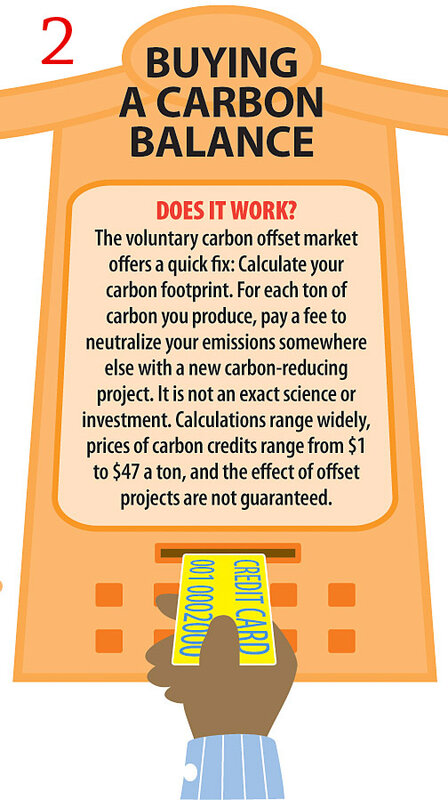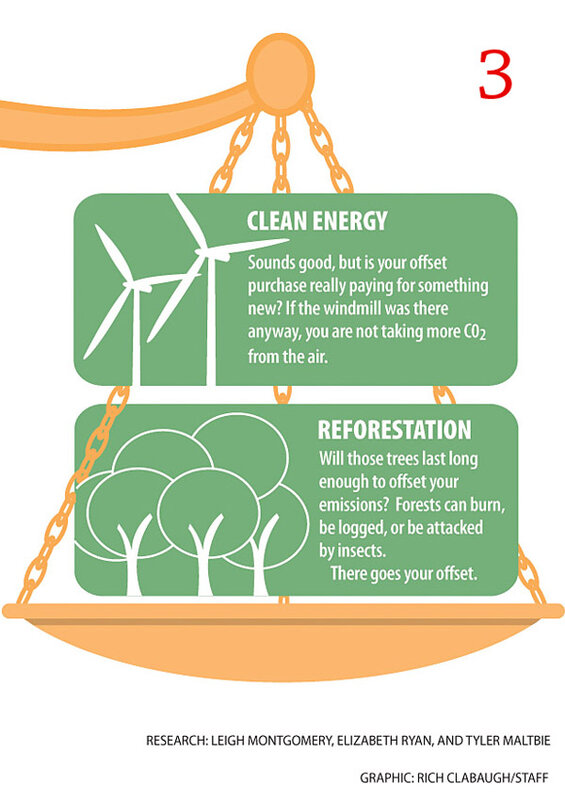Buying carbon offsets may ease eco-guilt but not global warming
Loading...
| Tiszakeszi, Hungary
This four-month multimedia investigation by reporters on five continents is a joint project of the Monitor and the New England Center for Investigative Reporting. It was funded, in part, by The Deer Creek Foundation. ��
A forest was supposed to be here, inhaling carbon dioxide. But the fields are as empty as the promises of the carbon offsets that promoters said would help negate global warming with thousands of new trees near this Hungarian village.
An investigation by ���Ǵ��� and the has found that individuals and businesses who are feeding a $700 million global market in offsets are often buying vague promises instead of the reductions in greenhouse gases they expect.
They are buying into projects that are never completed, or paying for ones that would have been done anyhow, the investigation found. Their purchases are feeding middlemen and promoters seeking profits from green schemes that range from selling protection for existing trees to the promise of planting new ones that never thrive. In some cases, the offsets have consequences that their purchasers never foresaw, such as erecting windmills that force poor people off their farms.
Carbon offsets are the environmental equivalent of financial derivatives: complex, unregulated, unchecked and – in many cases – not worth their price.
And often, those who get the “green credits” thinking their own carbon emissions have been offset, are fooled. The Vatican was among them.
Cardinal Paul Poupard stood for the flash of cameras in the Vatican in the summer of 2007, beneath an image of Jesus healing a blind man, and accepted a gold-framed certificate declaring the papal city the “first carbon-neutral sovereign state.”
By negating all the Vatican’s 2007 greenhouse-gas emissions with carbon offsets presented to the Holy See by the company KlimaFa, “the Vatican will do its small part in contributing to the elimination of polluting emissions … threatening the survival of this planet,” the cardinal proclaimed.
No one was happier about it than Kiss Lajos. The stubby 65-year-old has presided as mayor of the scratch-poor farming village of Tiszakeszi in the Hungarian plains since the days of the Soviets.
For his constituents, who scavenge brush along the Tisza River for their home fires, the ceremony in the Vatican offered rare hope: The Hungarian company KlimaFa promised to hire hundreds of workers to plant thousands of trees near their village to suck up carbon on behalf of the Vatican.
It did not happen.
KlimaFa has not planted a tree on what it ambitiously dubbed “the Vatican Forest” in the Tiszakeszi countryside, even as the California promoter who started the company used the publicity to sell offsets on the Internet.
The Hungarian government, initially a cheerleader of the project, now does not want to talk about it. The company’s president in Budapest backed out of an interview. The greenhouse gases produced by the cars and furnaces and lights of the papal apartments in the Vatican were not neutralized by the offsets. And a Vatican spokesman says “the case is being studied to take legal action in order to defend the Vatican’s reputation.”
“They were duped,” says Jutta Kill, an analyst for FERN (Forests and European Union Resource Network), which tracks environmental scams. And the Vatican was hardly alone.
Tens of thousands of buyers purchase carbon offsets yearly to help neutralize their global-warming pollution. They pay $5, $10, $20 or more from green-swathed sites on the Internet, or pay extra for offsets when they purchase airline tickets, rent a car, or ship a package. Companies buy them in bulk to help project a “green” image. Government agencies and civic organizations get offsets believing the purchases will make their actions “carbon neutral.”
They have created a worldwide market estimated by analyst Ecosystem Marketplace at $705 million in 2008. In the United States alone, offset sales have tripled in five years.
But these offsets – some sold through respected environmental organizations – come with almost no rules: There is little regulatory oversight of them in the US, no enforcement of requirements to prove their environmental claims, no certain way of measuring the carbon savings being sold, and no guarantees that planted trees or other projects will be finished or continued long enough to work.
The result, critics say, is a “Wild West” market ripe for fraud, exaggeration, and poorly run projects.
The investigation by NECIR and the Monitor found examples of irregularities in the market that include:
•An offset project in India that cleared plots of traditional tribal farmlands to build windmills for green electric power, upending some farmers’ livelihoods and – in the end – generating significantly less power than expected.
•A tree-planting project in Panama that promises profits for logging as well as calling itself a certified offset program when it is not. Few trees have even been planted.
•Scams in Australia that have prompted the alarmed government to launch a crackdown.
•A California promoter who launched a ship to spread iron dust in the South Pacific to grow carbon-sucking algae, a plan that the Environmental Protection Agency said would amount to illegal dumping at sea.
•An Israeli charity that is selling offsets that are supposed to create brand-new projects, for tree plantings it has been doing for 60 years.
Such examples are causing some supporters of carbon offsets to back off what they once saw as a promising tool to help the environment. And the troublesome record concerns those who want a national carbon cap-and-trade program in the US that would use offsets.
“I think you are looking at 75 percent of them as garbage, at least,” says Rolf Skar, a forest conservationist and senior investigator for Greenpeace in San Francisco.
RAPID GROWTH RIPE FOR ABUSE
Some consumers are becoming wary. The US House of Representatives dropped plans to make its Capitol offices “carbon neutral” last year after spending $89,000 on offsets. Nike shoes abandoned them this year as untrustworthy. Responsibletravel.com, a British travel agency that claimed to be the first to offer carbon offsets in 2002 as a centerpiece of its business, has quit relying on them to help the environment. Instead, the company urges its clients to fly less.
The US Government Accountability Office (GAO) in 2008 found “limited assurance of credibility” in voluntary offsets. A parliamentary inquiry in Britain in 2007 found a long list of flaws with offsets and concluded that they have “no overarching, enforceable standards.”
Australia takes the most vigorous stand: Regulators pounced on one company for selling offsets for renewable energy it did not have, they charged another with false practices; and they are investigating allegations that natives in neighboring Papua New Guinea were deceived into surrendering carbon rights for what the natives call “sky money.”
“This is a sector that’s starting to rear a couple of ugly heads,” says Graeme Samuel, head of the Australia’s consumer protection agency.
Many voluntary carbon offsets are sold online through retailers with eco-friendly names. Others are sold as add-ons: Travel companies allow customers to “fly green,” UPS customers can offset the cost of shipping packages, Ford car buyers can drive “carbon neutral” for $29.95 per year, and the Harvard Law School urges students to buy offsets when they travel for job interviews.
Greenpeace and other environmental organizations have been reluctant to completely reject carbon offsets, which are supposed to help achieve goals they support: drawing down greenhouse-gas levels in the atmosphere, protecting forests, promoting alternative energy, and encouraging individual action on the global climate problem.
Groups such as The Nature Conservancy, the Environmental Defense Fund, and the Sierra Club argue that some offset projects are run by well-intentioned developers and succeed in their claims. And offset retailers say they do good work.
“There is a great opportunity here to be able to subsidize the reduction of emissions,” says Pete Davies, president of the retail operations of Terrapass, a San Francisco offset provider that helps farmers pay for methane capture systems. “We see farmers being able to do the right thing that otherwise they wouldn’t be able to do. We’re excited to be a part of that.”
The appeal of doing something to help the environment has fed the rapid growth of offset sales.
“I buy them every time I fly,” says Matt Durden, a Reston, Va., attorney who figures he spends about $30 on carbon offsets through Expedia when he and his wife travel. He did not ponder the purchases long; they seemed a cheap and easy way to help the environment, he says.
Governments worldwide are contemplating mandatory offset programs, like that established in Europe under the Kyoto agreement. A top United Nations climate official predicted in 2006 that buying and selling carbon pollution reductions would become a $100 billion-a-year market, potentially the world’s largest commodities market.
Voluntary purchases are a small part of that, but even a small slice of such a big pie has created a burgeoning industry of offset developers, wholesalers, retailers, and promoters; the GAO counted at least 600 players in the US alone in 2008.
Mr. Skar, of Greenpeace, says the industry is rife with financial speculators in flannel shirts: “Carbon cowboys. People from the most bizarre backgrounds. People who have no prior interest in the environment.”
HOW IT WORKS
The theory of carbon offsets is straightforward. For example, a traveler who generates a ton of carbon dioxide pollution by driving about 2,000 miles in an average car can purchase an offset to pay for the reduction of a ton of carbon dioxide somewhere else in the world. The offset might promise that trees will be planted, methane digesters will be installed on farms, or new windmills will be financed by the purchase.
Where the reduction occurs doesn’t matter, proponents argue, as long the atmosphere is relieved of that ton of carbon. Others are queasy about the notion of paying to relieve their environmental responsibility.
Carol King Cummings, a Polson, Mont., retiree thinks of the offset concept this way: “My great-great-grandfather paid someone to fight for him in the Union Army in the US Civil War. This always embarrassed me a little. Carbon offsets strike me the same way.”
For the theory to work, several requirements must be met. The most vexing is that the traveler’s purchase must create a reduction in greenhouse-gas emissions that would not have happened without the traveler’s money. If the traveler pays for something that was going to be done anyway, that is double-counting and the traveler’s emissions are not offset.
This requirement of “additionality” has been difficult to apply, and critics say many projects are selling offsets to reap bonus profits for projects already being created for other purposes.
Windmill farms, for example, typically are built only if they can sell the electricity and also get substantial government subsidies or tax credits. On expensive projects like these, offset developers typically provide a small portion of the construction cost. Critics say the projects would probably go ahead with other funding, so developers should not claim credit for creating new carbon reductions.
��“It might sound great, like a wind farm. Who can be against a wind farm?” says Anja Kollmuss, who has studied offsets for the nonprofit Stockholm Environmental Institute. “But wind farms are very likely to have been built for something else. For the consumer, it’s incredibly difficult to understand.”
The Jewish National Fund (JNF), for example, has been urging Jews worldwide to “plant a tree in Israel” since 1948. Now, it is offering a “GoNeutral” calculator to figure how many trees one needs to offset one’s carbon emissions. JNF says one $10 tree over a lifetime of 70 years will absorb one ton of emissions.
“What the JNF is doing carbon-wise is not additional. Anything you do that is business-as-usual is not eligible for a carbon-offset purchase,” protests Eyal Biger, the founder of the Good Energy Initiative, a nonprofit Israeli organization that also sells offsets for trees. Mr. Biger’s group contends its trees are planted in urban areas, and are therefore new and additional.
Rabbi Eric Lankin, a JNF official, contends the GoNeutral purchases pay to plant trees beyond the group’s business-as-usual quota. But he acknowledges the rules on trees and offsets are hazy: “The challenge is that this is not an exact science.”
Others reject the theoretical underpinning of offsets: They are created by claiming to do something that would not normally have been done, and then predicting how much carbon would be produced with – and without – that action.
“The trouble is nobody can really verify – unless you can read a crystal ball –what would have happened. There are an infinite number of possibilities,” says Ms. Kill, at FERN.
Offsets also are required to be permanent, or reasonably close to it. Carbon dioxide, the largest component of greenhouse gases, may last for 100 years in the atmosphere. But offsetting a ton of carbon dioxide by planting trees, vulnerable to destruction, does not assure permanence.
“Trees get blown down by wind. They burn in forest fires. They are eaten up by insects. The trees are harvested, or they die from old age,” says Kill. “Forests are probably the worst pick” for offsets. They are, however, a favorite of promoters because of their symbolic appeal. According to Ecosystem Marketplace, forestry projects in 2008 spawned an estimated 5 million tons of offsets at an average price of $8.44 per ton.
But if forests are cut or destroyed, there is no legal requirement – and little incentive – for the buyer or the seller to replace the lost carbon savings, Kill notes.
“You take a holiday and you want to offset your flight. You go to one of these terminals or online, and you buy your carbon credits. What’s the potential of you as an individual – unless you are extremely dedicated or skilled – to find out what exactly is happening to the project in five or 10 years’ time?” Kill asks.
PAYING NOT TO CUT TREES
Critics also question where the money provided by offset purchases really goes. With no regulatory oversight, there is no disclosure of profit margins, and the finances of offset providers are shrouded in claims of confidentiality. The analytic firm Ecosystem Marketplace says the industry “resembles the Wall Street of the 1800s – with information closely guarded by those who profit from it.”
The San Francisco offset provider 3Degrees, for example, sells offsets through an ATM-like kiosk recently installed, with much publicity, at the San Francisco International Airport. Travelers can use the machine to offset emissions from their flights – at $13.50 a carbon ton – expecting to buy a new carbon savings somewhere.
In fact, they are paying 3Degrees to send money to two environmental groups – The Nature Conservancy and the Conservation Fund – for a promise not to cut down trees on land the environmental groups already own. The groups estimate how much carbon would be lost if they opened their northern California forest to logging, and they sell that amount as an “offset.”
Jason Brown, a spokesman for 3Degrees, declined to say how the offset sales are split.
Silva Tree, a promoter that sells plots of trees in Panama, takes the opposite tack. It promises investors that it will plant trees in Panama that will be logged in five years, bringing “guaranteed” returns of $145,200 if they pay $32,500 now for a hectare (2.5 acres) with 660 trees. Investors cannot buy offsets. But Silva Tree advertising and telephone sales personnel say that the project involves, or will involve, certified carbon offsets. Sales representatives suggest that hundreds of acres of the “biggest reforestation project in Panama” have been planted. In a visit to the site with Silva Tree contractors in February, The Monitor found only about 25 acres planted.
Such uncertainties worry officials like Javier Arias, the environmental minister of Panama. The government must be vigilant so that what companies “say is going to happen, must happen,” he said in an interview. “Everybody pays for a bad apple.”
Even offset providers acknowledge the industry is rife with abuses. “There’s a lot of bad stuff going around,” says Roger Ryall, who sells offsets to car dealerships in Canada. “There are guys out there planting grass and trying to sell offsets from it. You have to be careful.”
CALCULATE YOUR FOOTPRINT
Most offset sellers offer their products with an online sales pitch urging customers to “calculate your carbon footprint” with the site’s calculator and then to buy the equivalent amount of carbon dioxide emissions reductions. But results of those calculators vary widely, a study by Ms. Kollmuss at the Stockholm Environmental Institute found. Prices of carbon range from $1 to $47 a ton, according to Ecosystem Marketplace, which has done the only comprehensive financial study of voluntary offsets.
In answer to such complaints, some independent organizations – such as the Voluntary Carbon Standard, Plan Vivo, and Gold Standard – offer their seal of approval to projects. Offset providers say nervous customers should look for those certifications.
But the certifications remain voluntary, and the standards of the organizations vary – there were at least 17 of them in 2009. Many conduct only on-paper reviews of the offset projects, with no physical inspection of the project nor follow-up to see if the claimed reductions really occurred, Kollmuss says.
Nor is there regulatory verification of companies’ claims of certification. In its online brochure Silva Tree claims approval from the most widely known certification, Voluntary Carbon Standard (VCS), in labeling its Panama project a “VCS Carbon Offset.” Questioned about the claim, Silva Tree officials acknowledge they are not certified, but are in the process of applying, and anticipate selling offsets in the future. Other offset sellers use vague wording about “VCS standards” to imply certification they do not have. “Proving the legitimacy of carbon offset projects remains a major issue,” said a 2009 Ecosystem Marketplace report.
David Hales, who has represented the US in international environmental negotiations and now is president of College of the Atlantic in Bar Harbor, Maine, headed a 2008 effort of college presidents to draw up guidelines for offset purchases by colleges and universities. None of the certifications met the standards of his group.
“The market is dominated by junk,” Mr. Hales says. At his own college, he set students to the project of picking offsets to counteract emissions, and they found the effort a quagmire.
“It almost takes a full-time staff to determine exactly what you are getting. Even then, there is a range of uncertainties,” Hales says. “It’s truly a ‘buyer beware’ situation.
This article was written and reported by Doug Struck of the New England Center for Investigative Reporting, with contributions from reporters Ben Arnoldy in India, Sara Miller Llana in Panama, Ilene R. Prusher in Israel, Kathy Marks in Australia, and Katy Jordan and Tyler Maltbie in Boston.


